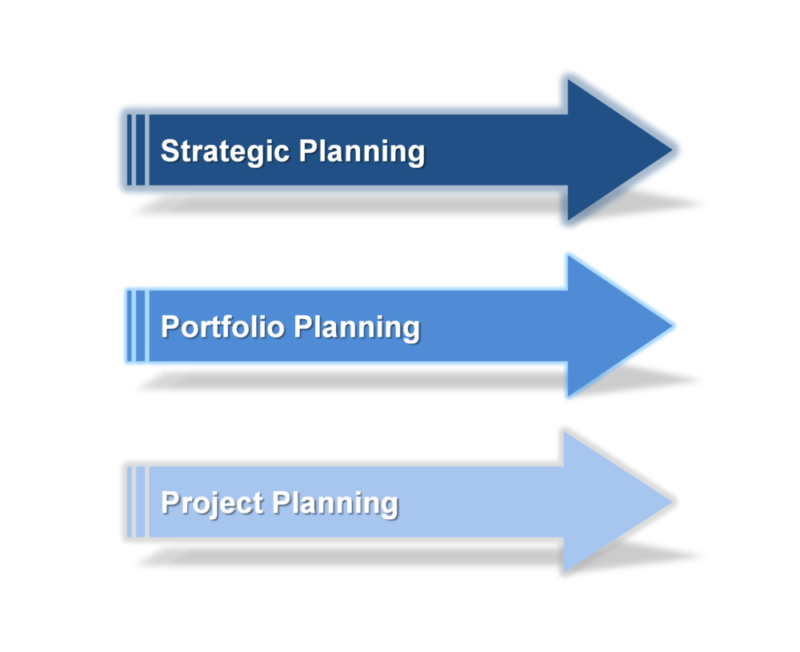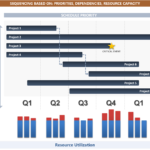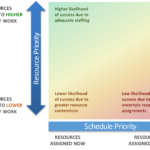Portfolio Planning Drives Strategic Execution
Portfolio planning drives strategic execution, but when compared to strategic planning and project planning, very few companies do an adequate job of portfolio planning. Project portfolio management is about strategic execution with the goal of maximizing business value delivery. Successful portfolio planning synthesizes what the company or organization aims to achieve at the strategic level and helps select projects at the tactical level that will fulfill those strategic goals. In this post we will cover the primary elements of portfolio planning and how you can incorporate it into your existing portfolio management processes.
Three levels of Planning (Strategic Planning, Portfolio Planning, and Project Planning)
Let’s quickly cover three different types of planning that an organization can do:
- Strategic planning: an executive leadership process to set the direction of the company to fulfill its mission and goals by establishing strategic objectives to fulfill those longer-term goals. Strategic planning entails developing organizational strategy that communicates where the company is going and why. One of the primary outputs of strategic planning is a strategic roadmap.
- Portfolio planning: a senior leadership activity within project portfolio management to reconcile the strategic plan with the right projects and to sequence those projects according to priorities, resources, dependencies, and current environmental conditions.
- Project planning: a team-based process to develop the scope, activities, timing, budget, and resources needed to complete the project, while accounting for risk. This answers the question of “WHAT are we doing?” and “HOW are we doing it?”
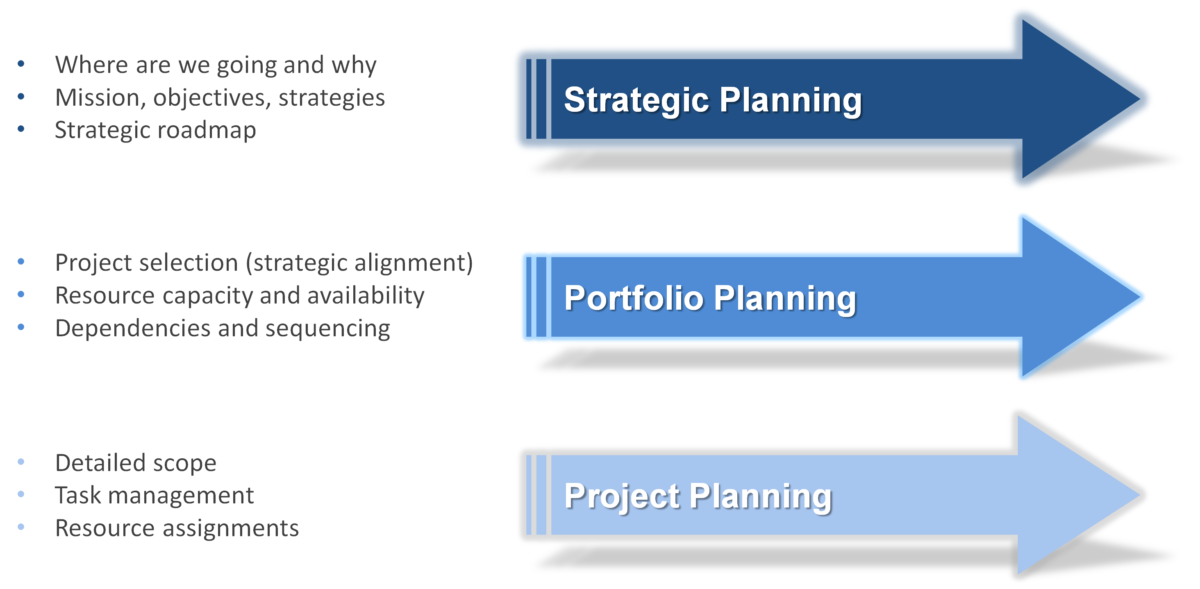
The Details of Portfolio Planning
Many of the components of portfolio planning are standard processes of good portfolio management. The problem is that many organizations omit one or more processes and do not adequately tie these processes together in a way to plan out the portfolio. We will summarize the key processes below and then discuss how we tie it together.
Critical Capabilities
- Strategic synthesis – strategic synthesis is a strategic element of portfolio management that goes hand in hand with project selection. A strategic roadmap or strategic plan is a prerequisite for determining what projects are needed to fulfill the strategic plan. In some cases the strategic plan has concrete goals or targets that can be fulfilled by key projects. In other cases, the strategic plan is more general that provides long-term guidance on the type of work needed for the company or organization to succeed. In either case, some level of analysis is needed to identify gaps in the strategic plan and ensure that the right projects are initiated at the right time in line with the strategic roadmap.
- Project Prioritization—prioritization in the context of portfolio planning is used to ensure that higher priority projects are initiated at the right time; lower priority projects may need to be pushed out later into the future so as not to interfere with the delivery of high priority work. This presumes that new requests are evaluated and scored early in the portfolio process in order to determine relative importance in the portfolio. The image below highlights the relationship between resource priority, schedule priority, and project success. Higher priority work gets adequately staffed and is scheduled earlier than lower priority projects.
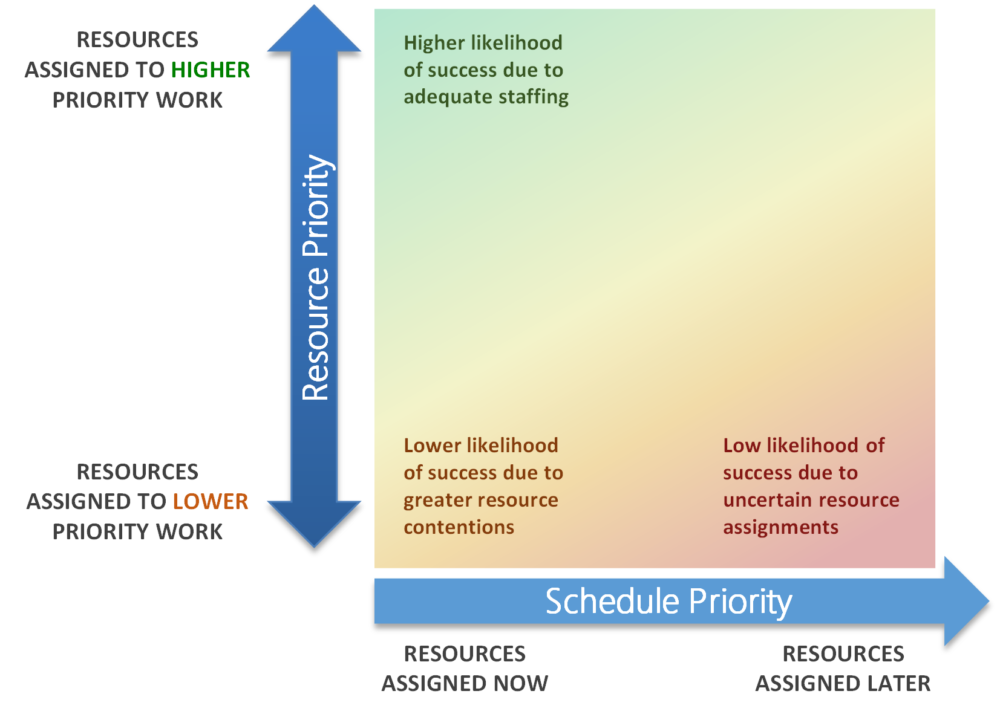
- Managing project interdependencies—some projects have an important relationship to other projects in the portfolio (e.g. one project cannot start until another project is finished, there is a lower cost to running projects concurrently, etc.). Understanding dependencies helps Portfolio Managers sequence projects to minimize conflicts, reduce risk, deliver on time and on budget, etc. PMO’s and Portfolio Managers should develop a dependency management process in order to have clear line of sight of all relationships between projects in the portfolio. We believe that in the near future, Artificial Intelligence (AI) and Machine Learning will greatly assist in identifying project dependencies.
- Evaluating resource capacity—some understanding of resource capacity and utilization is necessary in order to properly sequencing projects. This will help avoid resource conflicts of critical bottleneck resources and help ensure successful project delivery.
- Managing organizational impacts—organizations can only absorb a certain amount of change at one time; PMO’s and Portfolio Managers need to monitor the launch timing of projects and the relative impacts to internal and external stakeholders. Proper sequencing will minimize organizational disruptions.
VIDEO: What is Portfolio Planning?
How To Tie These Elements Together
Portfolio planning begins with strategic synthesis of the strategic plan in order to identify any gaps in the portfolio. This analysis may be performed by a Strategy team or a member of the PMO that is involved with portfolio management. New projects that are identified from this analysis should then go through the standard intake process for vetting and project planning.
At this point, there are several portfolio management disciplines that come together to support portfolio planning. As projects pass through a work intake (or Phase-Gate) process, new projects should be evaluated and scored in order to determine the relative value and riskiness of each project initiative. Priorities should drive the timing and resource allocation of all projects in the portfolio. Even ‘important’ projects should be evaluated and compared to the rest of the portfolio.
Resource utilization should also be accounted for in order to construct a realistic portfolio. Without understanding the resource utilization of key resources, there is a high risk that some critical teams will be over-utilized thereby jeopardizing overall portfolio delivery. Senior leaders that want to protect specific project delivery need to understand resource capacity and ensure that their critical resources are not stretched thin across too many projects.
In order to support project sequencing, PMO’s and Portfolio Managers must have a process for identifying and tracking project dependencies. Just as Project Managers must create realistic project schedules that take into account dependencies between activities, so should PMO’s and Portfolio Managers ensure that projects are sequenced according to key dependencies between projects. It is far too tempting for senior leaders to launch new projects at the same time without accounting for dependencies between projects; this is one way organizations get into trouble. Good portfolio management software will provide the PMO with necessary charts and dashboards to support portfolio planning.
Finally, there may be critical need dates for certain projects. This could be related to an executive mandate, market pressure, product launch, etc. These dates also need to be factored into sequencing projects in the portfolio. The image below highlights how we tie these concepts together.
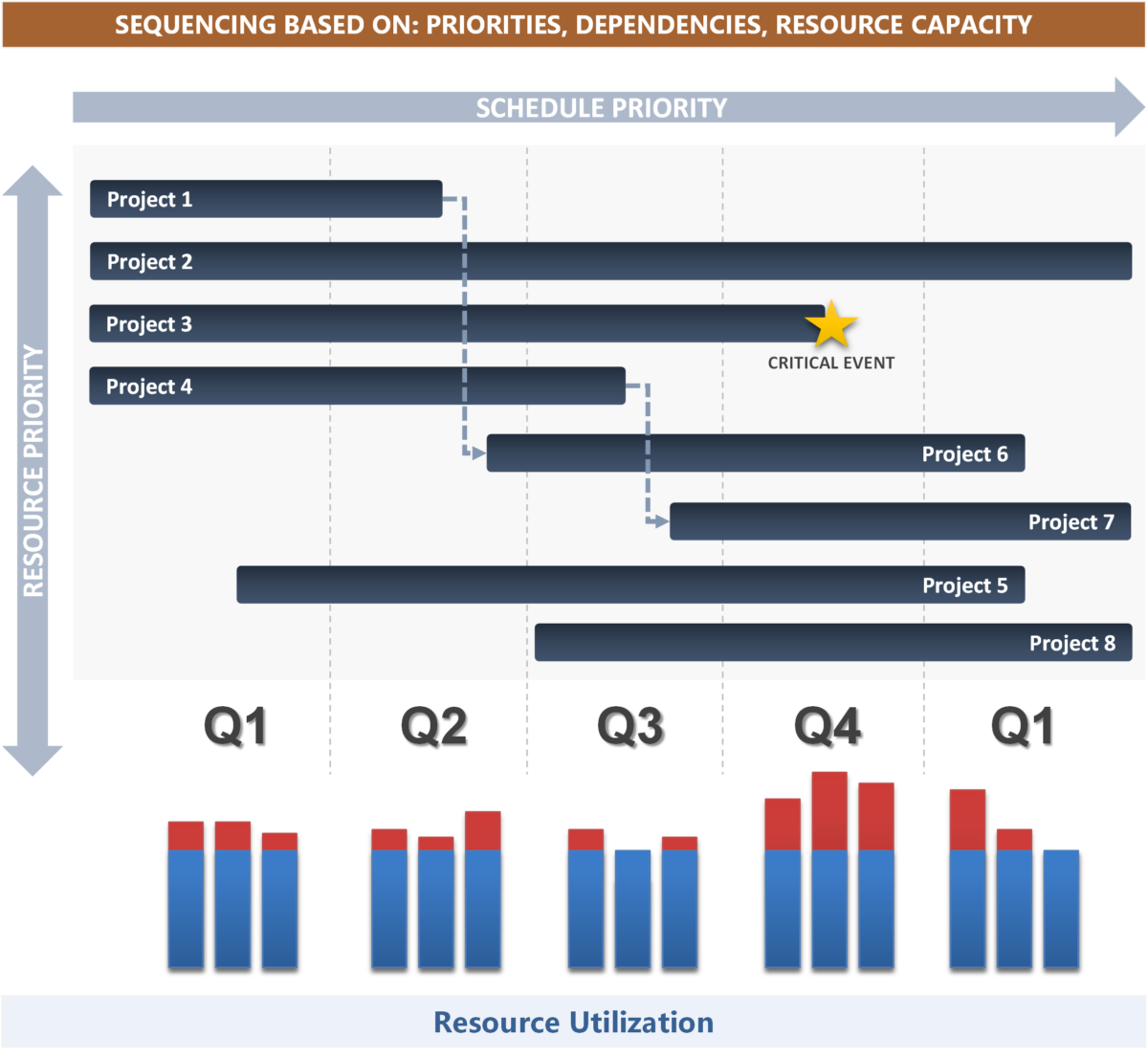
Multi-Project Critical Chain for Portfolio Planning
We believe that Critical Chain Project Management (CCPM) can be very effective for optimizing the schedules of multiple projects across the portfolio in support of portfolio planning.
Critical Chain Project Management originates from the Theory of Constraints which emphasizes that every system has a bottleneck or ‘constraint’ which limits the output (throughput) of a good or service. Critical Chain Project Management is a project management application of the Theory of Constraints that recognizes that a small number of key resources (‘bottleneck resources’) are the key constraints to completing project work on time. When Project Managers understand the resource constraints and schedule according to it, they can achieve fantastic results. Applying Critical Chain Project Management combines resource optimization and schedule optimization together and greatly enhances portfolio planning. It prioritizes the scheduling of tasks that utilize bottleneck resources in such a way that the bottleneck resources are not over-utilized while still accounting for other schedule dependencies and relationships across project schedules. Organizations that want to excel in portfolio planning should consider Critical Chain Project Management.
Portfolio Planning by Lifecycle Stage
We will briefly cover portfolio planning from the angle of the portfolio lifecycle. As we manage a portfolio there is ongoing work to define the portfolio (largely through selecting the right projects), followed by optimizing the portfolio, and then protecting portfolio value (through project execution). Each step of the portfolio lifecycle emphasizes a different component of portfolio planning.

Define the portfolio: Portfolio Planning at this life cycle stage is focused on providing visibility of the project pipeline and the long-term strategic roadmap. This is where strategic synthesis is very important. PMO’s and the portfolio governance team should maintain constant visibility of the strategic roadmap and ensure that the right projects are initiated at the right time.
Optimize portfolio value: portfolio planning at this life cycle stage is focused on optimizing the sequencing and timing of approved projects based on resource constraints and dependencies. The emphasis here is to use optimization techniques to maximize the value that the portfolio can deliver. For lower maturity organizations it would entail utilizing prioritization and capacity planning techniques to construct as good of a portfolio as they are capable.
Safeguard portfolio value: portfolio planning at this life cycle stage is focused on maintaining the strategic roadmap in light of changing conditions and dates during project execution. The emphasis here is to tactically protect the existing strategic roadmap by actively managing project and portfolio risks, dependencies between projects that could jeopardize project delivery, schedule delays across projects, and others changes in the project environment. This is a more holistic approach to protecting portfolio value.
Agile Portfolio Planning (Lean Portfolio Management)
Portfolio planning in an agile world looks different from traditional portfolio management. The concept is around lean portfolio management that puts more decision making into the hands of product teams that manage product backlogs. Agile portfolio planning still includes a strategic element, but governance is largely decentralized. A portfolio backlog does exist, but organizations may only be looking 6-12 months into the future. Funding decisions are largely related to value streams (i.e. to determine how much funding to give a specific value stream or product).
A Final Word About Portfolio Planning and Organizational Maturity
Portfolio planning brings together multiple portfolio management capabilities in order to drive even greater strategic execution. Most organizations utilize some of the capabilities such as prioritization and capacity planning, but many miss the synergy of using them in an interconnected way. Companies can still achieve solid prioritization at level 2 maturity and may begin resource capacity planning at level 2, but gaining the synergy of portfolio planning and being able to successfully sequence projects based on priority, resources, and dependencies really begins at level 3 portfolio maturity. At this point, portfolio governance teams can solidly use the fundamental capabilities and take it a step further to strategically plan the portfolio.
Tim is a project and portfolio management consultant with over 15 years of experience working with the Fortune 500. He is an expert in maturity-based PPM and helps PMO Leaders build and improve their PMO to unlock more value for their company. He is one of the original PfMP’s (Portfolio Management Professionals) and a public speaker at business conferences and PMI events.
[activecampaign form=3]
What are the three aspects of strategic planning?
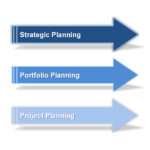
Strategic planning to develop the strategy and sets the direction of the company to fulfill its mission and goals. Portfolio planning to reconcile the strategic plan with the right projects and sequencing these projects appropriately according to priorities, resources, dependencies, and current environmental conditions. Project planning to develop the scope, activities, timing, budget, and resources needed to complete the project, while accounting for risk.
What is Agile portfolio planning?
Portfolio planning in an agile world looks different from traditional portfolio management. Agile portfolio planning still includes a strategic element, but governance is largely decentralized. A portfolio backlog does exist, but organizations may only be looking 6-12 months into the future. Funding decisions are largely related to value streams (i.e. to determine how much funding to give a specific value stream or product).
Never miss an Acuity PPM article
Don't take our word, listen to what others are saying:
"I find value in all of your articles."
"Your articles are interesting and I am sharing them with my team who have limited project knowledge. They are very useful."


